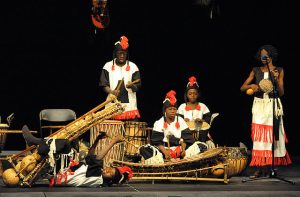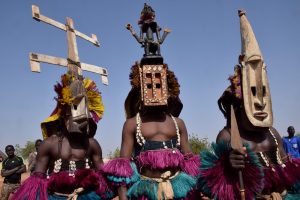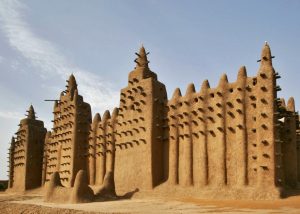Its music, masks, and mud architecture are integral parts of Burkina Faso’s identity, reflecting its historical depth, contemporary evolution, beliefs, and artistic expression. Burkina Faso, a landlocked country in West Africa, is renowned for its rich cultural heritage, including a vibrant music scene, intricate mask traditions, and distinctive mud architecture.
Music: The Rhythmic Heartbeat
Music holds a central place in Burkinabe culture, serving as a powerful medium for community expression and cultural preservation. The country’s musical traditions are deeply rooted in its ethnic diversity, which includes groups such as the Mossi, Bobo, Lobi, and Gourmanché. Traditional music in Burkina Faso is characterised by its use of various instruments, including the balafon and djembe. These instruments are central to the traditional rhythms and songs that accompany ceremonies and festivals.
According to the Burkinabe Ministry of Culture, approximately 1,200 traditional music ensembles are active across the country, participating in cultural events and festivals (Burkinabe Ministry of Culture, 2023). The enduring popularity of traditional music is evident in festivals like FESPACO (Pan-African Film and Television Festival of Ouagadougou) and the Festival de la Musique du Sahel, which showcase the country’s musical heritage to an international audience.
In recent years, Burkina Faso’s contemporary music scene has experienced significant growth, with artists such as Sina H and Troupe Benkadi gaining both local and global recognition. This modern wave of music often blends traditional rhythms with genres like reggae, rap, and pop, reflecting a dynamic evolution in the country’s musical landscape. The 2024 Burkinabe Music Industry Report highlights a 15% growth in the industry over the past five years, driven by digital consumption and global collaborations. Platforms such as YouTube and Spotify have been instrumental in expanding the reach of Burkinabe artists.
Masks: Faces of Ancestors
Masks are a crucial aspect of Burkina Faso’s cultural heritage, frequently used in ceremonies, rituals, and festivals. These masks, intricately carved from wood and adorned with feathers, beads, and other decorations, represent various spirits, ancestors, and deities, and are believed to possess supernatural powers.
Among the most famous masks in Burkina Faso are the “bwa” masks, found in the northern part of the country, distinguished by their elongated faces and elaborate headdresses. Other notable masks include the “gre” masks from the south, known for their vibrant colours and geometric patterns. Recent studies indicate that there are over 300 distinct types of masks in Burkina Faso, each associated with specific cultural practices (National Museum of Burkina Faso).
The craftsmanship involved in mask-making is highly esteemed, with artisans dedicating significant time and effort to creating intricate designs. However, traditional mask-making is under threat from urbanisation and modernisation. Organisations such as the Burkinabe Cultural Heritage Foundation are striving to preserve these traditions by training young artisans and promoting the cultural significance of masks. International exhibitions and collaborations further help to raise global awareness of Burkinabe masks, underscoring their artistic and cultural importance.
Mud Architecture: A Testament to Ingenuity
Mud architecture is a hallmark of Burkina Faso’s architectural heritage, characterised by the use of locally sourced materials such as clay and straw. This traditional building technique, noted for its sustainability and aesthetic appeal, is exemplified by structures like the Great Mosque of Bani in Djibo. Built entirely from mud bricks, the mosque is renowned for its impressive minarets and intricate wall designs and is recognised as a UNESCO World Heritage site.
Recent data from the Burkinabe Ministry of Urban Development indicates that approximately 60% of rural housing in Burkina Faso utilises traditional mud-building techniques. Despite the increasing prevalence of modern architectural styles in urban areas, there is a growing movement to incorporate traditional mud architecture into contemporary designs. This trend reflects a commitment to maintaining cultural heritage while promoting sustainable building practices.
However, mud architecture faces challenges, including vulnerability to erosion and the impacts of climate change. The Burkinabe National Institute for Architectural Research reports that increased rainfall and temperature fluctuations are causing deterioration in some traditional mud structures. In response, preservation efforts are being made, including research into more resilient building techniques and the promotion of sustainable construction practices.
Burkina Faso’s music, masks, and mud architecture collectively embody a vibrant cultural heritage that continues to evolve while maintaining deep connections to the country’s historical roots. The ongoing appreciation and preservation of these traditions are crucial for sustaining Burkina Faso’s rich cultural identity and ensuring that its cultural treasures remain a source of pride and inspiration for both local and global audiences. Through recent developments and international recognition, Burkina Faso’s cultural heritage is being celebrated and preserved for future generations.





